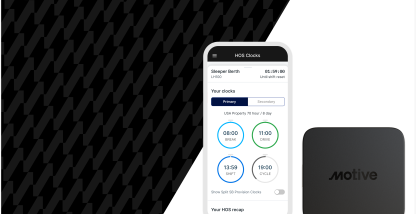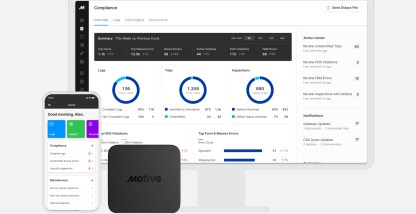On Dec. 15, 2015, the FMCSA published the final ELD rule. As per that rule, FMCSA-registered electronic logging devices (ELDs) became mandatory for non-exempt commercial drivers from Dec. 18, 2017.
Commercial vehicles that already had AOBRDs installed before Dec. 18, 2017, were given two more years to switch from AOBRDs to ELDs. That deadline is commonly referred to as the “grandfather clause,” and it expires on Dec. 16, 2019.
Why did the FMCSA announce the ELD mandate?
According to the official announcement by the FMCSA:
“(FMCSA) announced the adoption of a Final Rule that will improve roadway safety by employing technology to strengthen commercial truck and bus drivers’ compliance with hours-of-service regulations that prevent fatigue.”
The idea is to improve the enforcement of hours of service rules by recording them automatically through a compliant electronic logging device. Strict enforcement of hours of service rules is expected to improve road safety for commercial drivers as well as passenger vehicles.
Data from the FMCSA revealed that hours-of-service compliance improved after the implementation of the ELD mandate.
In Nov. 2017, before the ELD mandate requirements took effect, up to 1.16% of driver inspections had at least one hours-of-service violation. In January 2018, the HOS violation ratio dropped from 1.16% to 0.83%. In May 2018, after full enforcement of the ELD mandate, it dropped even further to just 0.64%.
What are the key ELD mandate requirements?
The ELD mandate has four key requirements, as per the FMCSA:
- It establishes which drivers must comply with the ELD mandate.
- It also sets certain design and performance standards that electronic logging devices in the market must meet to be compliant with the FMCSA.
- The ELD rule also identifies the supporting documents that drivers and carriers are required to keep.
- The ELD mandate protects drivers from harassment by detailing the steps drivers need to take.
Let’s discuss each requirement of the ELD rule in detail.
1. Who must comply with the ELD mandate requirements?
Do you need an electronic logging device?
According to the FMCSA, the ELD mandate requirements apply to most motor carriers and drivers who are currently required to maintain records of duty status, commonly referred to as RODS, as per Part 395, 49 CFR 395.8(a).
However, there are certain exceptions.
The ELD mandate requirements don’t apply to:
- Drivers who drive vehicles with pre-2000 engines
- Drivers in certain Driveaway-Towaway operations
- Drivers who are not required to maintain a Record of Duty Status (RODS)
- Drivers who only maintain RODS for 8 days or fewer in a rolling 30-day period
Many intrastate drivers now also have to install ELDs. For instance, Texas intrastate drivers need to install compliant electronic logging devices no later than Dec. 16, 2019. Intrastate drivers in Florida have until Jan. 1, 2020, to require drivers to use electronic logging devices and comply with the ELD mandate.
2. Are all ELDs in the market compliant with the FMCSA’s standards?
No, not all ELDs are FMCSA-registered.
It is up to you to select an electronic logging device that meets the ELD compliance requirements.
The FMCSA has a self-certification process for ELDs. There are hundreds of ELDs listed there, but not all of them are necessarily fully compliant.
During the 2017 FTR Transportation Conference, Ex-FMCSA Head, Annette Sandberg, said:
“As a former regulator, the biggest concern I have is the number of ELD vendors that are currently on the FMCSA list [of approved vendors] that probably should not be.” Vendors on this list are supposed to have ELD systems that can be self-certified, which means they meet the criteria and can be added to the approved list.
Annette Sandberg recalled a real-life example in which she found out that a popular company, which sold Electronic Logging Devices to a carrier with over 3,000 trucks, didn’t actually have a compliant ELD solution.
Here are a few tips for you when selecting a compliant ELD solution:
- Make sure the ELD solution is in the FMCSA’s list of self-certified ELDs. If an ELD solution isn’t on the list, it is not compliant.
- Check the list of revoked ELDs and make sure that the ELD you are about to install isn’t on this list.
- Verify that the ELD meets all the specifications mentioned here.
3. What are the supporting documents?
There are five categories of supporting documents that are needed to verify a driver’s RODS in normal circumstances:
- Bills of lading, itineraries, schedules, or equivalent documents that indicate the origin and destination of each trip
- Dispatch records, trip records, or equivalent documents
- Expense receipts related to any on-duty, not-driving time
- Electronic mobile communication records, reflecting communications transmitted through a fleet management system
- Payroll records, settlement sheets, or equivalent documents that indicate what and how a driver was paid.
Drivers are not required to have physical copies of electronic mobile communication and payroll records. These can be maintained electronically.
Additionally, each supporting document must contain the following information:
- Driver name (or a carrier-assigned identification number) on the document or on another document that allows the carrier to link the first document to the driver. The vehicle unit number can be used if that number can be linked to the driver
- Date
- Location (including the name of the nearest city, town, or village)
- Time
The Supporting Documents regulation is found at 49 CFR 395.11.
4. How do ELD mandate requirements protect drivers from harassment?
Some carriers might harass drivers and coerce them to drive beyond their hours of service. Harassment may also include interrupting a driver’s off-duty time, providing an unrealistic arrival time, and editing a driver’s log to get more work time.
The ELD rule encourages drivers to report harassment and file a written complaint under rule 49 CFR 386.12(b).
A harassment complaint must be filed within 90 days of the incident and must include:
- The name, address, and phone number of the driver
- The name and address of the carrier that harassed the driver
With ELDs, logs are recorded automatically. This minimizes the possibility of driver harassment. Data cannot be edited without the driver’s certification, and original data is preserved even if a record is edited.
Try Motive
If you are looking for a reliable, affordable, and FMCSA-registered ELD solution, try Motive.
The Motive ELD solution is loved by thousands of drivers, and it offers numerous fleet management features to increase efficiency and profitability. According to an independent study, the Motive ELD and fleet management solution is up to 50% easier to study.
Request a free demo today to learn more.









